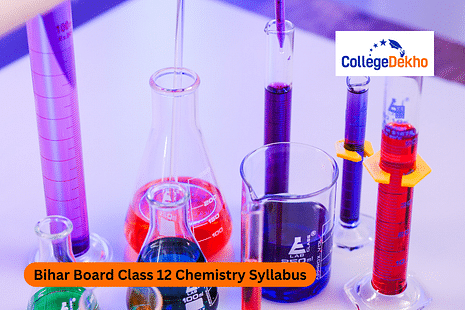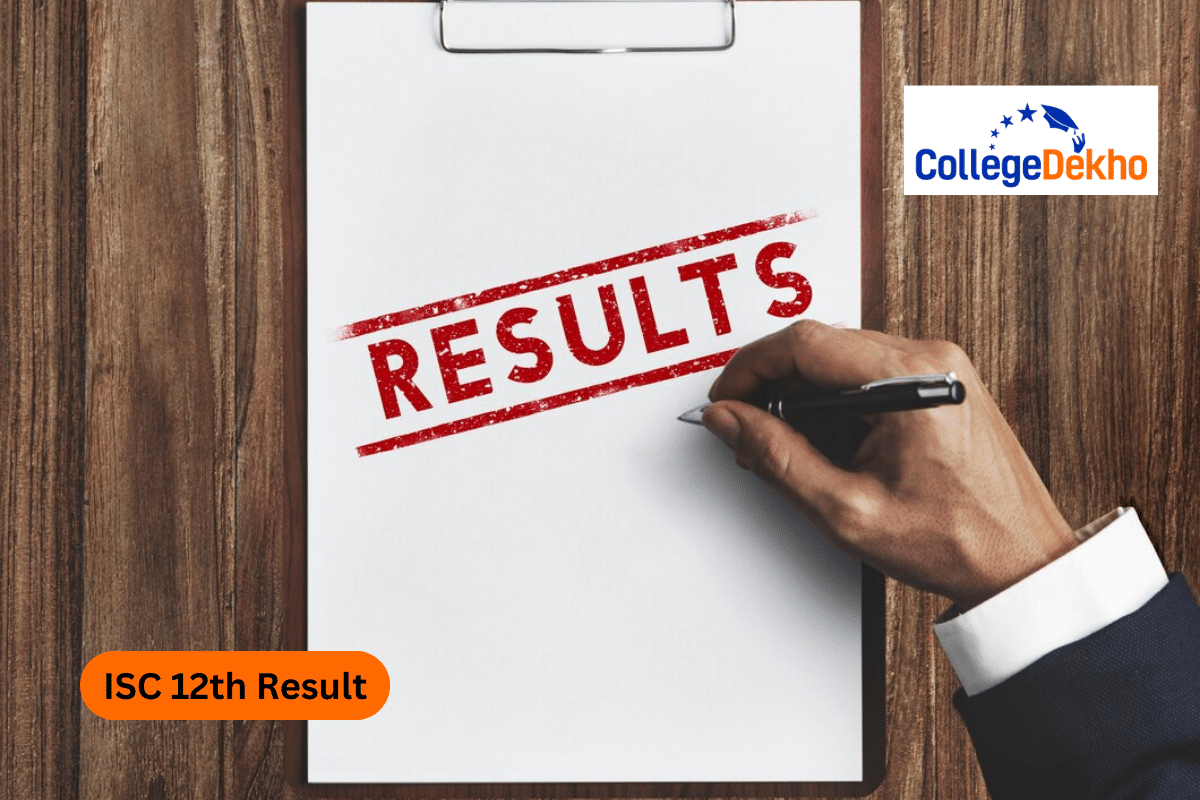- Bihar Board Class 12 Chemistry Syllabus 2025 PDF
- How to Download Bihar Board Class 12 Chemistry Syllabus 2025?
- Bihar Board Class 12 Chemistry Syllabus 2025: Unit Wise
- Bihar Board Class 12 Chemistry Syllabus 2025: Exam Pattern
- Bihar Board Class 12 Chemistry Syllabus 2025: Practicals
- Bihar Board Class 12 Chemistry Syllabus 2025: Practical Exam Pattern
- Bihar Board Class 12 Chemistry Syllabus 2025: Books
- Faqs


Never Miss an Exam Update
Bihar Board Class 12 Chemistry Syllabus 2025 includes a total of 15 units. Students can download the detailed syllabus on the official website of the Bihar School Examination Board once it is released. The units included in the syllabus are Solutions, Electrochemistry, Chemical Kinetics, Surface Chemistry, General Principles and Processes of Isolation of Elements, p-block Elements, d and f-block elements, Coordination Compounds, Haloalkanes and Haloarenes, Alcohols, Phenols, and Ethers, Aldehydes, Ketones, and Carboxylic Acids, Organic Compounds Containing Nitrogen, Biomolecules, Polymers, and Chemistry in Everyday Life.
The theory exam for Chemistry will be conducted for 70 marks and the remaining marks are allotted for the practical exam. Students can refer to the Bihar Board Class 12 Chemistry Model Paper 2025 to practice for the board exams. Students must check the theory syllabus and practical syllabus separately to study for the board exams. Check out more information about Bihar Board Class 12 Chemistry Syllabus 2025 here:
Bihar Board Class 12 Chemistry Syllabus 2025 PDF
Right now, the BSEB 12th Chemistry Syllabus 2025 is not available on the official website. Below, we have shared the direct PDF for the previous year's syllabus:
| Bihar Board Class 12 Chemistry Syllabus PDF |
|---|
How to Download Bihar Board Class 12 Chemistry Syllabus 2025?
There is a simple procedure that can be followed by the students to download the Bihar Board Class 12 Chemistry Syllabus 2025. Check the procedure given below:
- Step 1: Students must first visit the official website of the Bihar School Examination Board at secondary.biharboardonline.com/
- Step 2: On the homepage, they have to click on the Syllabus option present on the menu bar.
- Step 3: From the drop-down menu, select class 12th.
- Step 4: The list of PDFs for different syllabi will open on the screen. Click on the Chemistry option to download the syllabus.
Also Read: Bihar Board 12th Chemistry Previous Year Question Paper
Bihar Board Class 12 Chemistry Syllabus 2025: Unit Wise
Students can check out the information related to the topics coming in the different units for Chemistry subject from the table given below:
Units | Topics | Weightage |
|---|---|---|
Unit 1: Solutions | Types of solutions, expression of concentration of solutions of solids in liquids, the solubility of gases in liquids, solid solutions, colligative properties lowering of vapor pressure, the elevation of boiling point, depression of freezing point, osmotic pressure, determination of molecular masses using colligative properties, abnormal molecular mass. | 23 |
Unit 2: Electrochemistry | Redox reactions, conductance in electrolytic solutions, specific and molar conductivity, variations of conductivity with concentration, Kohlrausch’s Law, electrolysis and law of electrolysis (elementary idea), dry cell -electrolytic cells and Galvanic cells, lead accumulator, EMF of a cell, standard electrode potential, Nernst equation and its application to chemical cells, fuel cells, corrosion. | |
Unit 3: Chemical Kinetics | Rate of a reaction (Average and instantaneous), factors affecting the rate of reaction, concentration, temperature, catalyst; order and molecularity of a reaction, rate law and specific rate constant, integrated rate equations, and half-life (only for zero and first-order reactions); concept of collision theory (elementary idea, no mathematical treatment). | |
Unit 4: Surface Chemistry | Adsorption – physisorption and chemisorption, factors affecting adsorption of gases on solids, catalysis, homogenous and heterogenous activity, and selectivity; enzyme catalysis colloidal state distinction between accurate solutions, colloids, and suspensions; lyophilic, lyophobic multimolecular and macromolecular colloids; properties of colloids; Tyndall effect, Brownian movement, electrophoresis, coagulation, emulsion-types of emulsions. | |
Unit 5: General Principles and Processes of Isolation of Elements | Principles and methods of extraction – concentration, oxidation, reduction – electrolytic method and refining; occurrence and principles of extraction of aluminum, copper, zinc, and iron. | 19 |
Unit 6: p-block Elements |
| |
Unit 7: d and f-block elements | General introduction, electronic configuration, occurrence and characteristics of transition metals, general trends in properties of the first-row transition metals – metallic character, ionization enthalpy, oxidation states, ionic radii, color, catalytic property, magnetic properties, interstitial compounds, alloy formation, preparation and properties of K2Cr2O7 and KMnO4. Lanthanoids – Electronic configuration, oxidation states, chemical reactivity, and lanthanoid contraction. Actinoids – Electronic configuration, oxidation states. | |
Unit 8: Coordination Compounds | – Introduction, ligands, coordination number, color, magnetic properties and shapes, IUPAC nomenclature of mononuclear coordination compounds. Bonding, Werner’s theory, VBT, and CFT; structure and stereo isomerism, the importance of coordination compounds (in qualitative inclusion, extraction of metals and biological system). | |
Unit 9: Haloalkanes and Haloarenes | Haloalkanes: Nomenclature, nature of C-X bond, physical and chemical properties, mechanism of substitution reactions. Haloarenes: Nature of C -X bond, substitution reactions (Directive influence of halogen in monosubstituted compounds only). Uses and environmental effects of – dichloromethane, trichloromethane, tetrachloromethane, iodoform freons, DDT. | 28 |
Unit 10: Alcohols, Phenols, and Ethers | Alcohols: Nomenclature, methods of preparation, physical and chemical properties( of primary alcohols only), identification of primary, secondary and tertiary alcohols, mechanism of dehydration, uses with special reference to methanol and ethanol. Phenols: Nomenclature, methods of preparation, physical and chemical properties, acidic nature of phenol, electrophilic substitution reactions, uses of phenols. Ethers: Nomenclature, methods of preparation, physical and chemical properties, uses. | |
Unit 11: Aldehydes, Ketones, and Carboxylic Acids | Aldehydes and Ketones: Nomenclature, nature of carbonyl group, methods of preparation, physical and chemical properties, mechanism of nucleophilic addition, the reactivity of alpha hydrogen in aldehydes; uses. Carboxylic Acids: Nomenclature, acidic nature, methods of preparation, physical and chemical properties; uses. | |
Unit 12: Organic Compounds Containing Nitrogen | Amines: Nomenclature, classification, structure, methods of preparation, physical and chemical properties, uses, identification of primary, secondary, and tertiary amines. Cyanides and Isocyanides: will be mentioned at relevant places in context. Diazonium salts: Preparation, chemical reactions, and importance in synthetic organic chemistry. | |
Unit 13: Biomolecules | Carbohydrates: Classification (aldoses and ketoses), monosaccharides (glucose and fructose), D-L configuration oligosaccharides (sucrose, lactose, maltose), polysaccharides (starch, cellulose, glycogen) importance. Proteins: Elementary idea of α – amino acids, peptide bond, polypeptides, proteins, the structure of proteins – primary, secondary, tertiary structure and quaternary structures (qualitative idea only), denaturation of proteins; enzymes. Vitamins: Classification and functions. Nucleic Acids: DNA and RNA. | |
Unit 14: Polymers | Classification – natural and synthetic, methods of polymerization (addition and condensation), copolymerization, some important polymers: natural and synthetic like polythene, nylon, polyesters, bakelite, rubber. Biodegradable and non-biodegradable polymers. | |
Unit 15: Chemistry in Everyday Life | Chemicals in medicines: analgesics, tranquilizers, antiseptics, disinfectants, antimicrobials, antifertility drugs, antibiotics, antacids, and antihistamines. Chemicals in food: Preservatives, artificial sweetening agents. Cleansing agents: Soaps and detergents, cleansing action. | |
Total | - | 70 |
Bihar Board Class 12 Chemistry Syllabus 2025: Exam Pattern
The Chemistry question paper will have MCQs along with short and long-answer-type questions included in it. Check the exam pattern for the same from the table given below:
Question Type | Number of Questions | Number of Questions to be Attempted | Marks per Question |
|---|---|---|---|
MCQs | 42 | 35 | 1 |
Subjective Questions (Short Answer) | 18 | 10 | 2 |
Subjective Questions (Long Answer) | 6 | 3 | 5 |
Bihar Board Class 12 Chemistry Syllabus 2025: Practicals
Practical exams will be conducted for 30 marks in Chemistry in Bihar Board Class 12. Students can refer to the detailed information about the syllabus for the same from the table given below:
S.No | Experiment Topic | Description |
|---|---|---|
1 | Preparation of Inorganic Compounds | - Preparation of double salt of Ferrous Ammonium Sulphate or Potash Alum - Preparation of Potassium Ferric Oxalate |
2 | Electrochemistry | - Variation of cell potential in Zn/Zn2+ |
3 | Preparation of Organic Compounds | Preparation of any one of the following compounds Acetanilide Di -benzal Acetone p-Nitroacetanilide Aniline yellow or 2 - Naphthol Aniline dye |
4 | Surface Chemistry | - Preparation of one lyophilic sol (starch, egg albumin, and gum) - Preparation of one lyophobic sol (aluminium hydroxide, ferric hydroxide, arsenous sulphide) - Dialysis of sol prepared in lyophilic sol - Study of the role of emulsifying agents in stabilizing the emulsion of different oils |
5 | Determination of concentration/ molarity of KMnO4 solution by titrating it against a standard solution of: | Oxalic acid Ferrous Ammonium Sulphate (Students will be required to prepare standard solutions by weighing themselves). |
6 | Thermochemistry (Any one of the following experiments) | - Enthalpy of dissolution of Copper Sulphate or Potassium Nitrate - Enthalpy of neutralization of strong acid (HCl) and strong base (NaOH) - Determination of enthalpy change during interaction (Hydrogen bond formation) between Acetone and Chloroform |
7 | Chemical Kinetics | - Effect of concentration and temperature on the rate of reaction between Sodium Thiosulphate and Hydrochloric acid - Study of reaction rates of any one of the following: - Reaction of Iodide ion with Hydrogen Peroxide at room temperature using different concentrations of Iodide ions. - Reaction between Potassium Iodate (KIO3) and Sodium Sulphite (Na2SO3) using starch solution as an indicator (clock reaction) |
8 | Chromatography | - Separation of pigments from extracts of leaves and flowers by paper chromatography and determination of Rf values - Separation of constituents present in an inorganic mixture containing two cations only (constituents having large differences in Rf values to be provided) |
9 | Qualitative Analysis: | Determination of one cation and one anion in a given salt. Cation - Pb2 +, Cu2+, Al3+, Fe3+, Mn2+, Zn2+, Cu2+, Co2+, Ni2+, Ca2+, Sr2+, Ba2+ , Mg2+,[NH4] + Anions – [CO3] 2- , S2- , [SO3] 2- , [SO4] 2- , [NO2] - , Cl- ,Br- , I- , [PO4] 3- , [C2O4] 2- , CH3COO- (Note: Insoluble salts excluded) |
10 | Characteristic tests | Characteristic tests of carbohydrates, fats, and proteins in pure samples and their detection in given foodstuffs. |
11 | Tests for the functional groups present in organic compounds: | Unsaturation, alcoholic, phenolic, aldehydic, ketonic, carboxylic and amino (Primary) groups. |
Bihar Board Class 12 Chemistry Syllabus 2025: Practical Exam Pattern
The practical exam conducted by BSEB consists of different evaluation parameters as decided by the authorities. Check out the practical exam pattern from the table given below:
Evaluation Scheme | Marks |
|---|---|
Volumetric Analysis | 8 |
Salt Analysis | 8 |
Project Work | 4 |
Content-Based Experiment | 6 |
Class Record and Viva | 4 |
Bihar Board Class 12 Chemistry Syllabus 2025: Books
Students must study the Bihar Board Class 12 Chemistry Syllabus 2025 from the books prescribed by the Bihar School Examination Board. Check the details for the same here:
- Bihar Board Class 12 Chemistry by Dr K. P. Srivastav Alok Publication Books
- New Millennium Chemistry Class - 12 (vol-1 & 2)
- New Era Chemistry - Textbook For Class Xii Part I & Part Ii
- MTG NCERT Textbook + Exemplar Problem Solutions Class 12 Chemistry
Students must follow and understand the Bihar Board Class 12 Chemistry Syllabus 2025 in detail so that they can complete the preparation for the board exams as soon as possible. Revision can be done by using model test papers released by the Bihar School Examination Board on their official website or by using the previous years' question papers. The students need to complete the syllabus quickly so that they have enough time for revision.























